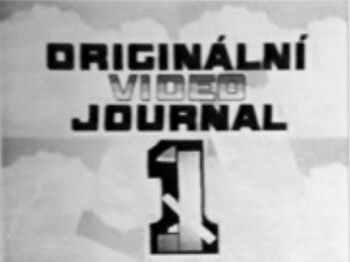Original Videojournal
Originální videojournal [Original Videojournal] was a dissident video magazine initiated by František Janouch and Václav and Olga Havel in 1987. It was edited and copied secretly on school equipment. Seven regular and two thematic programmes were produced between Autumn 1987 and November 1989, followed by nine special volumes made during and shortly after the 1989 revolution.
In the late 1987, an idea was born to not only send the video shots documenting the Czechoslovak dissident activities abroad, but also to produce a programme for the domestic audience. With the financial aid from the Czech exile centers abroad (Foundation of Charter 77, ČSDS – Czechoslovak Documentary Centre), the “Original Videojournal” editorial group acquired a video tape recorder Sony Video-8. This led to the production of video news from the dissident and alternative culture, covering political and ecological issues from the “unofficial” perspective.
The team originally wanted to publish and distribute the samizdat audiovisual periodical on VHS tapes two to three times a year. The title was coined by Olga Havlová together with Pavel Kačírek, who added the addendum "original" because in socialist Czechoslovakia it was not illegal to create a work but to distribute copies of it. Each edition was approximately two hours long and the videotapes with illegally made content were distributed in twenty copies. People naturally made additional copies by any means available. There were also tapes that were fourth or fifth generation copies.
Although they didn't realize it at first, the people around the journal were actually trying to create a competing samizdat television with a given structure. The dissident newscast began with Jan Holub's own original jingle, with a commentary by Andrej Krob, who clarifies in the reading text that it is only "one!" original.
The regular columns were supplemented by editorially prepared pictorial material, thus creating a diverse mosaic that presented the viewer a realistic view of the situation in Czechoslovakia. A considerable number of people, willing to risk exposure by the secret service (StB), were involved in the production. Alice Růžičková divides them into three groups: the narrow circle of the editorial board, which devised the dramaturgical concept, the content of the columns and the final form of the individual issues, the wider circle of collaborators, and those who helped with the financing of the technology and distribution abroad.
Core editorial group included Olga Havlová (editor, photographer), Michal Hýbek (cameraman, video editor, editor, distribution), Pavel Kačírek (editor-in-chief, cameraman, video editor), Jan Kašpar (cameraman, editor), Andrej Krob (cameraman, editor), Jan Ruml (editor responsible for the political section), Joska Skalník (editor responsible for the cultural section), and Andrej Stankovič (editor). Collaborators included Jarmila Bělíková (editor), Přemysl Fialka (cameraman, photographer), Aleš Havlíček (cameraman, who cooperated with the journal especially at the beginning), Jiří Kantůrek (editor, moderator of discussions), Jaroslav Kořán (editor, photographer), Jaroslav Kukal (cameraman, photographer), Milan Maryška (cameraman, editor), Petr Oslzlý (editor), Jiří Reichl (editor), Jiří Mergl (cameraman, sound engineer), David Schmoranz (cameraman). Other supporters included Karel Freund (liaison), František Janouch (Charter 77 Foundation - Stockholm, Sweden), Vilém Prečan (Č.S.D.S. archive - Scheinfeld, West Germany), Jiřina Šiklová (liaison), Pavel Tigrid (Svědectví publishing house Paris, France). (Růžičková 2000: 10-11)
Selection of videos of the Original Videojournal were shown publicly for the first time as part of the exhibition Historie československé demokracie [History of Czechoslovak Democracy], held at the U Hybernů house in Prague in Spring 1990, shortly after the Velvet Revolution.
Editions[edit]
- 0, Autumn 1987, 120 min
- 1, Spring 1988, 116 min
- 2, Autumn 1988, 176 min
- 3, Winter 1988, 179 min. Video (attachment), 54 min.
- 4, Spring 1989, 118 min
- 5, Summer 1989, 119 min
- 6, Autumn 1989, 83 min
- from 17 November 1989 (Velvet Revolution)
- 1, 2, from 17 Nov, 101 min
- 3, 4, from 24 Nov, 83 min
- 5, from 26 Nov, 67 min
- 6, from 2 Dec, 59 min
- 7, from 5 Dec, 27 min
- 8, 14 min
- 9, from 26 Dec, 37 min
- X, 27 Dec, general strike
Documentary film[edit]
- Czech TV programme series about Original Videojournal, 20 episodes, 26 min. each, 2011–2012.
Literature[edit]
- Chris Hill, "Where Independent Media Made a Difference: Citizen producers in Eastern Europe, 1989-1991", Community Media Review, Mar-Apr 1994.
- "Pavel Kačírek v rozhovoru s Chris Hill", in Chris Hill, Walking Trips in Czech Lands, Prague: FCCA, 1996. (Czech)
- "Pavel Kacirek Interviewed by Chris Hill", trans. Dana Recmanová, in Chris Hill, Walking Trips in Czech Lands, Prague: FCCA, 1996. (English)
- Joska Skalník, "Originální videojournal", Výtvarné umění 20:1-2, 1996. (Czech)
- Alice Růžičková, Český dokumentární film v 80. letech: "Originální Videjournal", Prague: FAMU, 2000, PDF. Master's thesis. (Czech)
- Alice Růžičková, "Originální videojournal: pokus o 'samizdatovou televizi'", in Alternativní kultura. Příběh české společnosti 1945–1989, ed. Josef Alan, Prague: Lidové noviny, 2001, pp 474-491. [1] (Czech)
- Pavlína Binková, "Aktivní videotechnologie: mediální studia, demokracie a video", Revue pro media 12-13, Brno, 2005, pp 6-11. (Czech)
- Alice Lovejoy, "'Video Knows No Borders': Samizdat Television and the Unofficial Public Sphere in 'Normalized' Czechoslovakia", in Samizdat, Tamizdat & Beyond: Transnational Media During and After Socialism, eds. Friederike Kind-Kovács and Jessie Labov, New York: Berghahn Books, 2013, pp 206-220. (English)
- Ivan Ruml, "Originální videojournal – co mi uvízlo v paměti", Paměť a dějiny 1, 2015, pp 92-94. (Czech)
